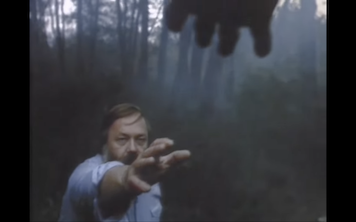
The protagonist's monologue also covers the entirety of Khutsiev's Mne dvadtsat , which debuted at the same time as the Nouvelle Vague and featured vivid street photography of Moscow's four seasons, and bridges the film with that of Mikhail Romm, the most ardent defender of the film against Khrushchev's ban (3). Khutsiev completed Romm's last project, And still I beleieve/I vsyo- taki ya veryu... (1974) in collaboration with Elem Klimov and others, in which Romm's voice, recorded for Triumph over violence/obyknovennyy fashizm (1965) , was used. And above all, it reminds me of the monologue in the mind of a female scientist in the masterpiece Nine Days of the Year/Devyat dney odnogo goda (1962). But this captivating voice and the poetic leap itself seem to have almost disappeared from today's cinema. Even in Russian cinema, such a moment is no longer possible, for example, in Andrei Zvyagintsev's The Return/Vozvrashchenie (2003), a mediocre film in which nature exists only as a visual backdrop in a very Western way. So what exactly was happening in Russian cinema after the collapse of the Soviet Union?
Dovzhenko's films of the silent era, which were made under the Soviet regime, were allowed for a different kind of storytelling and leaps as if it were a modern film, as Oliviera and Straub-Huillet (who themselves admit to being under the influence of Eisenstein) said (2), like Zvenigora (1927), in which an old man and his grandson who transcends time run from the age of legends to a futuristic city through a revolution. And in his wife Yulia Solntseva's Poem of the Sea/Poema o more (1958) , when a man returns from the war between Germany and the Soviet Union to rebuild his hometown and walks through the golden wheat fields with his child, a monologue in the man's voice evokes scenes of the past war between Germany and the Soviet Union, and suddenly a tank passes in front of him. A man, a doctor, trembling with fear of bombing, wields a scalpel and sees his comrades fallen by enemy bullets and his own blood stained figure... Or a man and a woman walk in the red dusk, the man in a hurry to rebuild the country, his monologue growing faster and faster, while the woman, left behind, lies sadly in the meadow. Then, with the sound of singing, the faces of the peasants appear, and the monologue of the man who appears as a doctor speaks to the woman. In the office, an angry man waves a stick, and suddenly the wall breaks down and the dam is swallowed up in a torrent of water...As Jean Luc Godard said, Solntseva's film, which everywhere uses communist propaganda and documentary-like images, together with beautiful voices and songs, naturally makes a mad leap into the past and fantasy, had an impact on him during the period of Pierrot le fou (1965).
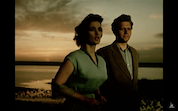
At about the same time as Khutsiev made Infinity, Alexander Sokurov mentioned Andrei Chernikh’s The Austrian Step/Avstriskoe pole (1991) as a wonderful filmmaker’s “jewel”. This strange film had even been shown at festivals in Russia along with Sokurov's films for a while. In addition, there is an another film that Chernykh wrote, Mirror Reflection/ Otrazheniye v zerkale (1992) by Svetlana Proskurina (who also wrote and filmed the making of Sokurov’s Russian Ark). If we add Otrazheniye v zerkale to the list, we can see a film that is searching for the sound that should have been attached when theater passed through silent film and discovered talkies, or a film that would have been made if people who went from experimental theater to silent film in the 1920s, such as Kozintsev, Trauberg, or Abram Room, had not engaged in communist propaganda and continued to do so today. The first thing that strikes us in these films is the visual element, but what is also important is the attempt at sound. In Austrian Step, featuring two women (Elena Bragina and Natalya Baranova), one unfulfilled while being chased by a man, and the other unfulfilled while chasing a man, seems to be two faces of the same person. It is a film of solitary characters wandering, as in the scene in which a woman, apparently an artist in futurist costumes of the 20s, invites men to her apartment, and the dialogue with the men in the gallery is actually a monologue in which the woman speaks to the camera. The wandering does not have any Antonioni-like elements, which even Sokurov's film had traces of, but rather it is filled with ideas that come from the theater, like Abram Room's A Severe Young Man/Strogiy yunosha (1935). It begins with a single scene, a single shot at the beginning that captures the profile of a woman as if to say the curtain is about to rise, and yet we are captured by the film because of the movement that transforms the monologue into multiple voices. In the flashback of a woman reminiscing over a glass of wine, the man and woman in the car seat continue a long dialogue, and then their off-screen voices, which could be called a dialogue of their monologues, or voices in their minds, are superimposed on it. The entire film is filled with a constant attempt to create a polyphonic space, like the scene of a moving shot in a mysterious forest where we suddenly hear a dialogue in Italian.
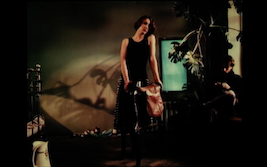
On the contrary, Reflections in a Mirror begins with a theatrical performance, where we hear the monologues of the actors. The film tells the story of an actor who loses himself in constant performance, but Proskurina's interest lies in the dialogue scenes. There is a recurring scene of an actor (Viktor Proskurin) walking with a dog, reminiscent of Tarkovsky's Nostalgia, but unlike Tarkovsky's film, it is the dialogue scenes that are most fascinating. In an interview, about the next film Remote access/ Udalionnyy dostup (2004), which Sokurov praised, she talked about the surprise of the moment when the different background sounds of each person interacting are connected by editing. For example, in the scene where the protagonist is drinking in his room with a young girl and another middle-aged woman who came along with him from the theater, Proskurina’s camera captures the facial expressions and changes during the off-screen person speaking. This is where she meets the great pioneers such as Godard and Cassavetes, though she's not as accomplished as them, but beautiful because it’s imperfect in a way. The slow tempo of the film is determined to capture this moment of change, a time that can only be closed up in film.
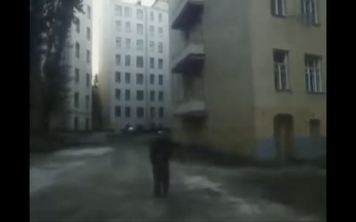
Compared to these films, Sokurov's Whispering Pages/Tikhie stranitsy (1994) is a film that uses very traditional methods and techniques to create a fantastic space. It is true that Sokurov's ability to compose the entire sound of a film, such as the familiar sound of a dog in the distance, the sound of a river nearby, the silence, and the melody of Mahler that can be heard faintly at the moment of decision, is completely unparalleled. For example, in the scene where the girl comes to visit the protagonist in his room, Vera Zelinskaya's set, quoted from Dostoevsky's "Crime and Punishment," where the approaching cameraman recedes and before he knows it he is outside, is similar to the technique used by Alain Resnais in In other words, it is derived from baroque plays such as Calderon de la Barca's "Life is a Dream," from which Raul Ruiz often draws inspiration. Also, despite the bizarre imagery of the submerged city and the people jumping down from the corridor above, the turnaround is a predictable edit that precisely follows the construction of the corridor of fictional space pursued in the film. The same can be said of the theatricality of the dialogue scene between the protagonist young man and the official, which includes a long tempo, silence, and even still images, but ultimately consists of a chain of screen turns, and the parting conversation scene between the young man and the girl, in which the camera approaching each other on the same axis. I also noticed that the scene in which the protagonist finds the resurrected Chekhov in the bathroom at the beginning of Stone/Kamen (1992) used the traditional cut back editing. Of course, this is not the case with the Elegy series (although even the most experimental Russian Elegy/ Elegiya iz Rossii (1993) used the false cutback editing of people looking at dead people), but the will to construct a closed fictional space in Sokurov's films is clearly shown in his choice of rhythms, colors, and rays of light, even in documentaries such as The Spiritual Voice/ Dukhovnye golosa (1996), and in the long, fixed prologue that forces the audience to accept in advance all the sounds that will be constructed later. And this will is increasingly evident in recent major works, from Molokh (1999) to Russian Ark(2000). So, is it safe to say that Sokurov, like Tarkovsky and Alexei German, or like Kozhintsev in his later years, belonged to the Soviet era of filmmakers who ultimately aimed to maintain this fiction = a rule firmly? This seems to me to be a far more important question than the tedious debates in closed discourse spaces and petit-Stalinist behavior toward film that we can expect when the new film The Sun is released in Japan.
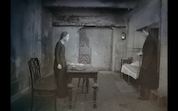
This question seems to become even clearer when we refer to the films, texts, and interviews of filmmakers with critical qualities who emerged after Sokurov. Oleg Kovalov, a film historian known for works such as Sergei Eisenstein, Autobiography/Sergey Eyzenshteyn, Avtobiografiya (1996) seems to have found in his works and texts a distance from which to reexamine the images of the Soviet era. While the psychoanalytical approach in Autobiography of Eisenstein and the juxtaposition of quotations from Méliès and Busby Berkley that seem to indicate an affinity for their images may not seem new, the quotations and the montage of Eisenstein himself in slow motion suggest that he is more of a comic personality than a great man. Eisenstein's own monologue, read by Alexey German, sounds as if it is a comment on his life as reflected upon by the already dead Eisenstein himself. In other words, it is not simply a matter of praise or denial, but an attempt to find a distance from which to view Eisenstein as an individual. It is a comparison of Leni Riefenstahl's film and Eisenstein's October on Radio Svoboda's website, pointing out the lack of light and tragedy in the former's romantic mythology, and the lack of reality in the former's inclusion of screens of people not saluting Hitler in newsreel footage of the streets of Germany. It can be felt in the series of historical contextualized reexaminations and analyses of classic films (Ivan the Terrible, Andrei Rublev, Barnet’s Secret Agent, etc.) by him and his critics, including the one that points out the reflection of the former (5). In other words, it makes us feel that it has become possible in Russia to take a stance to see the various functions of these films without dismissing them all as propaganda films in the service of communism and the Nazi. Kovalov's handling of footage differs from the montage of Artavazd Pelechian and Sokurov which extracts pure movement from it, in that it asks the viewer to reflect on the image as a medium.
It seems to me that this is a way of paying homage to the era in which we come from, while at the same time detecting the dangers of the future. The story of how Mikhail Romm, who was ordered by Stalin to make the communist propaganda film Lenin in October in 1937, a year after Stalin's death, removed Stalin's image from the negative of the film one night in 1937, when images once existed only in movie theaters (5), suggests that Romm might have been concerned with the future that he wasn't purged and had lived until after Stalin's death. (5) If Stalin did not realize that Romm had created the film in advance in case he was not purged and survived, it is a marvelous story considering that Stalin once ordered Romm, through his subordinate, to remake Ford's "The Thirteen". Nowadays, when I review "Lenin in October," I find that it is such an "interesting" film, with its gun battle scenes reminiscent of Godard's Prénom Carmen (1983) and the humorous character of Lenin, that it is hard to imagine that Stalin ever appeared in it. I wonder if it is possible for "ordinary people" who deal with immediate images and media today, and who are most affected by them on a daily basis, to have a clear vision of the actions of the artist in Triumph over violence (often referred to by Godard as a film about the Nazi using footage). Perhaps Kovalov's reflection is an attempt to preserve this vision by introducing perspective and time by distancing himself from the closed history of Soviet cinema.
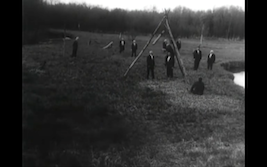
Evgeniy Yufit's films, on the other hand, introduces a different distance to the history of Soviet cinema. In 1985, at the end of the Soviet regime, he studied at the film school that invited Sokurov, who had just made The Lonely Voice of Man/Odinokiy golos cheloveka (6). He made his feature film debut with Papa, Santa Claus is Dead / Papa, umer ded moroz (1991), a remake of A.K. Tolstoy's The Vampire Family, (which was already made into a film by Mario Bava and Giorgio Ferroni) produced by Alexei Gelman. His films are junk of Soviet-made artistic science fiction films like those made by Tarkovsky. For example, Zhena Kerosinshchika/The Kerosene Salesman's Wife, shot in 1988 at the end of the Soviet Union by Aleksandr Kaidanovsky, the actor of Stalker, is contrary to popular opinion, an unforgettable film that is closer to Fassbinder and Schroeter than Tarkovsky. It tells the story of people who encounter a world of bizarre hallucinations (heavy snow suddenly falling on the weather, a flutist in flames, an angel of death, etc.) everywhere in their daily lives in 1953, the year of Stalin's death. It was also a prophetic metaphor for the Soviet Union, which would disappear a few years after the film's completion, but despite the use of a similar metaphor, there was a further distance between the film and Yufit’s films. It is a film that declares that the time when the state made art films is a natural thing is a past that can no longer be returned to, and it introduces distance by failing to become art. The experiment of merging plants and human beings by means of a horribly cheap device, which is repeated unsuccessfully by a group of scientists gathered in a secret base deep in the forest of Silver Heads/Serebryanye golovy (1998), can only produce junk people endlessly. But this is not just a trash film. The endless scenes of meaningless games played by junk people, somewhat reminiscent of Kiyoshi Kurosawa's Suit Yourself or Shoot Yourself series (1996~7), are a metaphor for the barrenness of the Soviet system, and at the same time, the almost noisy sound by Vyacheslav Gaivoronsky, who also composed the music for Proskurina’s Mirror Reflection, and the light reflecting on water and trees by Alexander Burov, Sokurov's cinematographer, are used to extract the beauty that still resides in matter and time from the details of junk. Yufit’s film seems to say that if there is something that we must affirm in a world where the communist system has lost its foundation and the capitalist system has become dysfunctional, it is the "nature" that can be seen beyond the filth and dust. This is something that the films of the 1920s, which he himself mentions, were discovering with the evolution of silent films. Eventually it died out in the encounter with communism, but now it is coming back to life from the ruins. So it is no wonder that all the characters in Yufit's films are zombies. It is also connected to the timeless immortal protagonists of Dovzhenko's early works, and to the images of "nature" that are created when documentary and fiction are mixed and can no longer be distinguished. But how long will this "nature" be an environment that we can affirm? The empty ending of Silver Heads tells us nothing about it.
From the point of view of the works of these later artists and their criticism, the image of Sokurov's works depicting those in power, starting with Molokh including the two works in the Elegy series depicting Yeltsin, would appear to be even more delicate, ambiguous, and complicated. This attitude of having to affirm the existence of models and history, the strange familiarity with evil, the distance and respect by avoiding the extremes of caricature and realism and deforming, may be justified by later history, as in the portraits of kings painted by many artists?
After the collapse of the Soviet Union and in the 21st century, we have strangely become even more distant from the films and images of the East than we were during the Cold War, but what we cannot lose sight of is the germ of a continuing reexamination and exploration of the images and sounds produced by the old regime. For example, Jean-Luc Godard in the 1980s, before his Histoire(s) du Cinema (1988~98), was already most consciously aware that he was making a film between the West and the East, and that he was mediating the forces of both sides through the natural images and sounds of films like Prenom Carmen, Je vous salue Marie (1985), and King Lear (1987). And just as Chen Kaige’s early 3 films were in the vein of Dovzhenko (while his later "Self- Modification" films are so disastrous), the connection between Chinese cinema and the land and factories can be unexpectedly found in works like Jia Zhangke's Platform (2000) and Wang Bing's Tie Xi Qu (2003). And speaking of Dovzhenko-esque, one can also find Victor Erice (Lifeline, a part of 10 Minutes Older, 2002), Marc Recha’s early films (don't forget Manoel de Oliveira's discovery of him), and even in Gus Van Sant's Gerry (2002) and Last Days (2005). The power of the image derived from Soviet cinema still seems to exist as an external force for American, European, and Asian cinema to rely on. The exploration of filmmakers who emerged after the collapse of the Soviet Union and the reexamination of Soviet-era images through this exploration are necessary for a future in which our own gaze is freed from the manipulated and dogmatic images we have come to hold of Russia.
Notes.
(1) Miron Chernenko, Nova Gazeta, n.90.
(2) As for Straub's words, see the catalog of the Turin Film Festival 2001; as for Oliviera’s words, see the remarks in the catalog of the Torino Film Festival 2000.
(3) Larisa Malyukova, Nova Gazzetta, n.8.
(4) Proskurina's interview with Sokurov is below. www.kinoart.ru/ magazine/07-2002/now/sokurov/
(5) www.svoboda.org/programs/Cicles/Cinema/Russian/
(6)Alla Yarko, Russian Journal, "Stalin Cinema near the side of the Pyrenees", 24/May/2000
(7) More details below. www.kinoart.ru/magazine/09-2004/names/ jufit0409/
(2005.04.01)